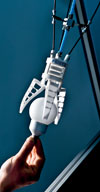
Festo is committed to applying natural principles to industrial practice and to utilising the biomechatronic results of this process in its automation systems. This culminated in the company’s Bionic Learning Network, which is an alliance of educational establishments and specialist companies tasked with exploring bionic solutions for evolutionary automation applications.
Drawing inspiration from nature’s ability to achieve maximum performance with minimal energy consumption, the Bionic Learning Network aims to develop decentralised, self-controlling and self-organising systems. The network’s main focus is on utilising bionics in the formulation of new principles of operation for the delivery of energy efficient, mechanical engineering innovations.
Bionic Handling Assistant
The Bionic Handling Assistant is the network’s newest offering, providing a completely flexible and safe means of moving objects from one position to another.

Elephant’s trunk
Inspired by an elephant’s trunk, the assistant employs innovative biomechatronics technology and introduces a new concept where direct contact between machines and their human operators is no longer hazardous. In the event of contact between the Bionic Handling Assistant and a human, the assistant will yield immediately without modifying its desired overall dynamic behaviour, and will resume its operation once the threat has been averted. Unlike other heavy industrial robots, this assistant is characterised by an excellent mass-payload ratio. In addition, it provides smooth operating motion with more degrees of freedom and makes efficient use of its resources in production and operation.
The assistant consists of three basic elements for spatial movement, along with a hand axis with ball joint and a gripper with adaptive fingers. The basic elements each comprise three circularly arranged actuators tapering at an angle of 3°. Each actuator is supplied with compressed air at the interfaces of the basic elements. Resetting is effected by the loop-like design of the actuators, which act like a spring when the compressed air is discharged. Bowden cable potentiometers on the outside of the actuators register their extension and control the system’s spatial movement. In the hand axis, three further actuators are arranged around a ball joint. Their activation displaces the gripper by an angle of up to 30°. SMAT sensors from Festo register the travel and make for precise alignment, while VPWP proportional directional control valves are used for the overall control of the Bionic Handling Assistant.
A revolution
Set to revolutionise the design of materials handling systems, this latest innovation could open up a host of new application areas that involve direct, non-hazardous contact between humans and robots. These include equipment used in hospitals, rehabilitation centres and care homes for the aged, agricultural machinery and animal husbandry.
Bionic tripod
Another pioneering handling solution from Festo, the BionicTripod 2.0 is derived from the tail fin of a fish and can be described as a horizontally arranged tripod that is rotated at 90° from the conventional tripod configuration. It consists of a drive unit, a tripod structure free to move in all spatial directions, a flexible hand axis and an adaptive FinGripper soft handling unit. The hand axis is structured similar to that of the Bionic Handling Assistant, with the added advantage of three extra degrees of freedom and a 30° range of deflection.

The highly versatile FinGripper constitutes the interface between the object and the actuators and consists of a pneumatic actuator in the form of a bellow and three gripping fingers.
Precise control and displacement of the tripod structure are ensured by the EGC electric linear axis and EMMS electric drive from Festo. The system is controlled by the CMXR robotic control software, which combines mechanics, electrical drive and control technology into a complete kinematic systems solution and coordinates highly dynamic spatial movements.
A particular advantage of the horizontal configuration is that objects can be picked up from the working surface and deposited to the side at a different level, a beneficial feature for versatile agricultural applications and for the sorting of materials for recycling. Since the structure is pliable and flexible, it is ideal for tasks in human-machine interaction and can be used in sorting applications or as a 'third' hand.
The tripod was developed to achieve a maximum scope of operation with a minimum weight of the moving parts, which enhances energy efficiency. It is an example of the forms energy efficiency may take in the future of automation technology. All this is made possible by electric linear actuators, electric motors, robotic control, pneumatic valves, sensor technology and control technology from Festo.
For more information contact Joanne Dexter, Festo, +27 (0)11 971 5560, [email protected], www.festo.com
| Email: | [email protected] |
| www: | www.festo.co.za |
| Articles: | More information and articles about Festo South Africa |

© Technews Publishing (Pty) Ltd | All Rights Reserved